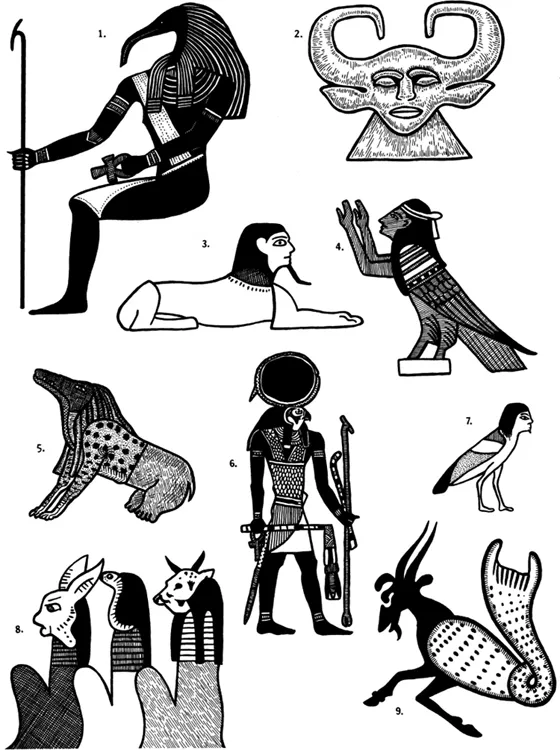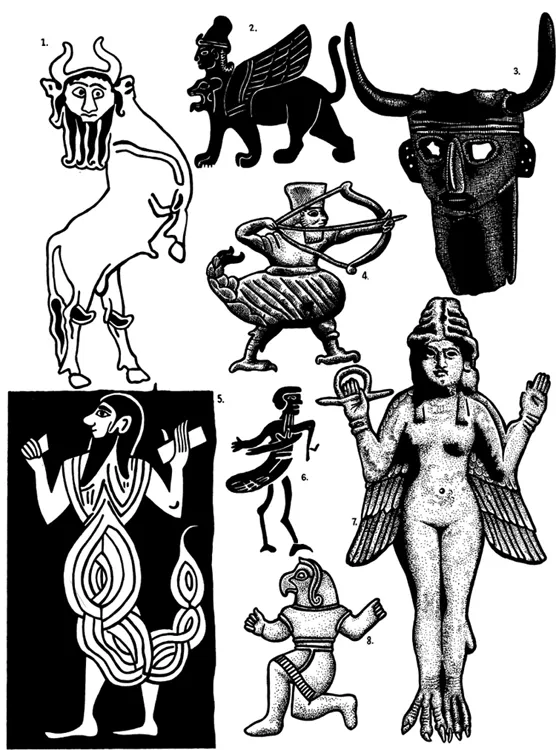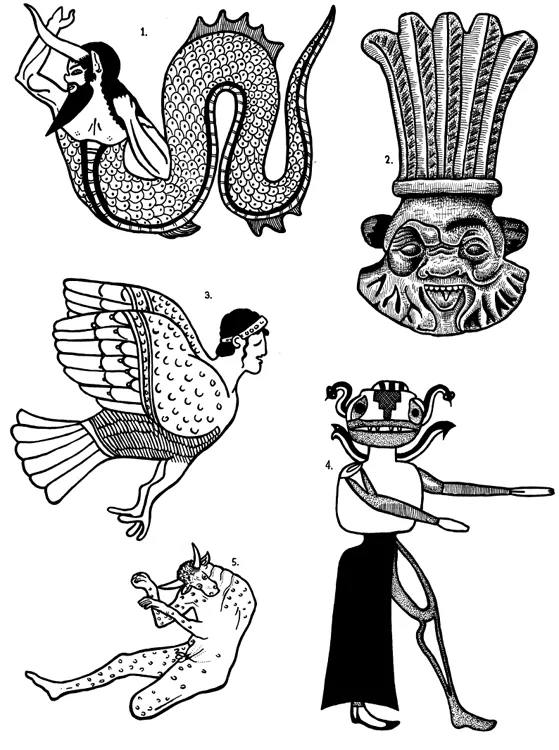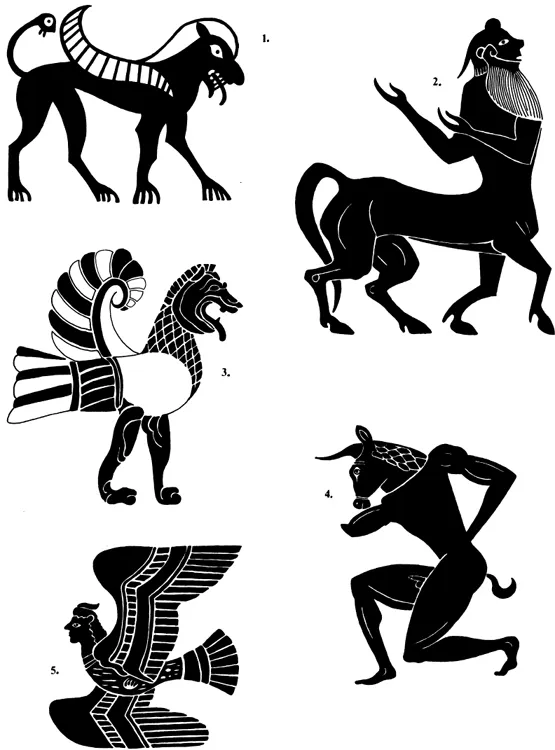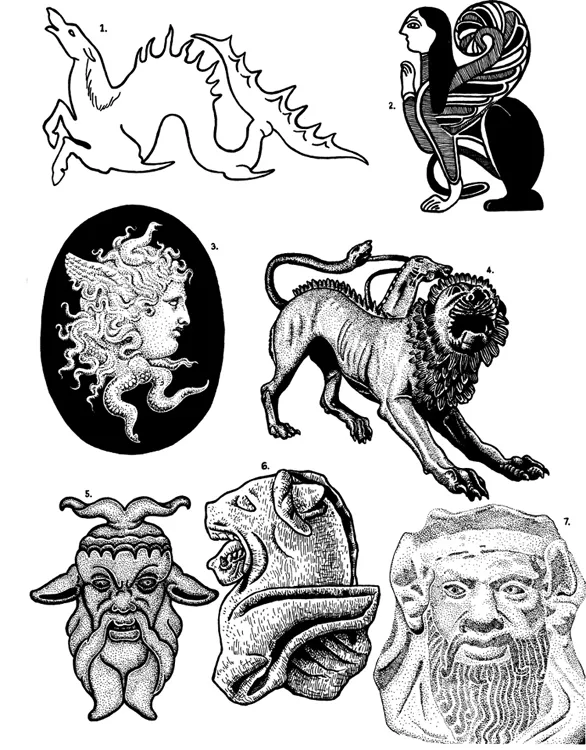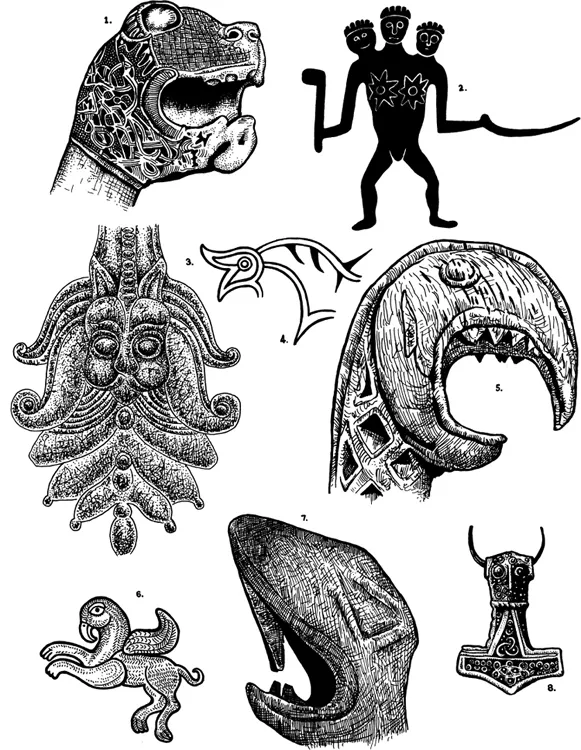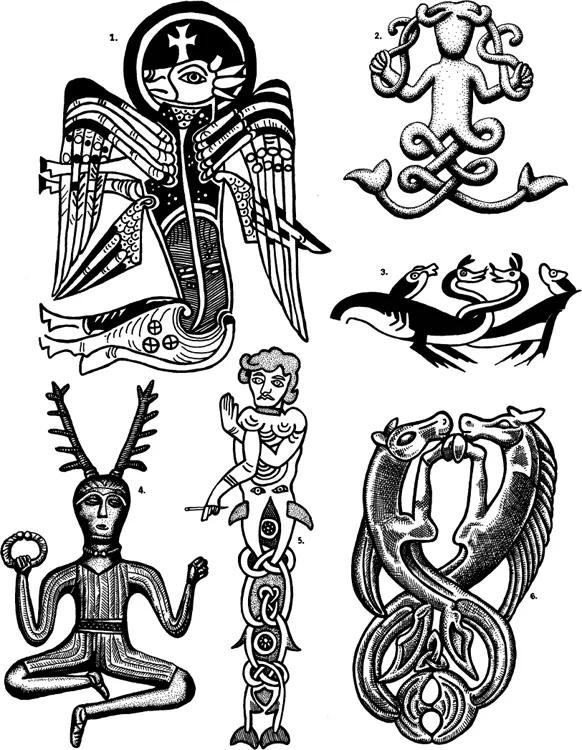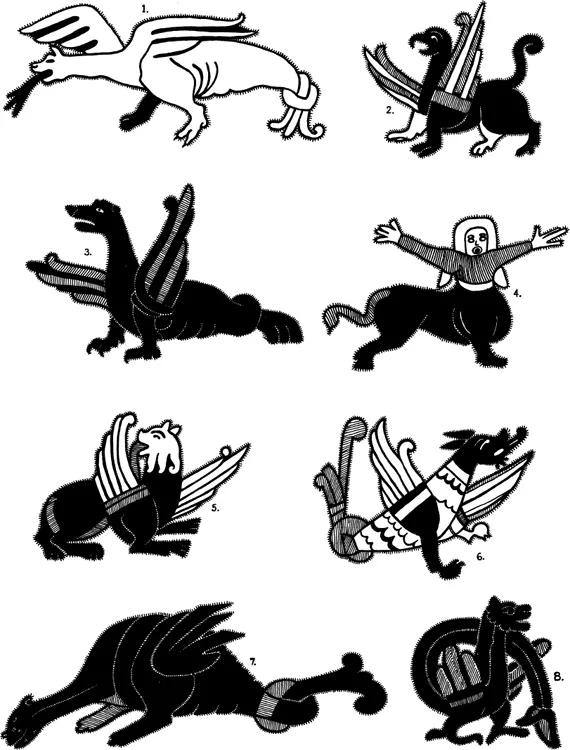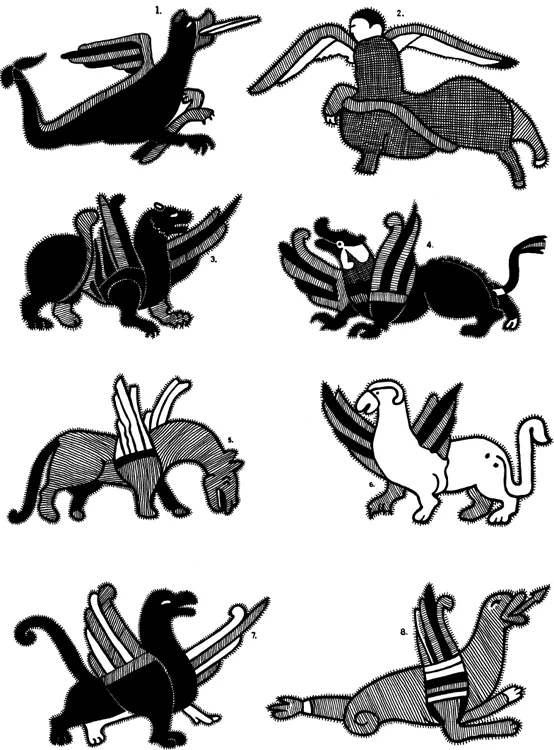![]()
Plate 1. ANCIENT EGYPT. 1. Thoth, from a tomb painting at Thebes. 2. Humanized buffalo head, Palette of King Namer, Hierakonpolis, ca. 3100 B.C. 3. Sphinx, from a papyrus. 4. Bai, or soul-bird, from a Book of the Dead. 5. Composite creature, from a papyrus. 6. Ra-Horakhte, from a painting at Thebes, 800 B.C. 7. Bai, or soul-bird, from a papyrus. 8. Three gods, from a papyrus. 9. Fish-tailed goat, zodiac figure from a sarcophagus, Thebes.
Plate 2. ANCIENT EGYPT. 1. From Karnak. 2. Bai, or soul-bird, from a wall painting, 13th century B.C. 3. Nehebka. 4. Anubis, from a papyrus. 5. Osiris. 6. Uraeus, from the tomb of Amenhotep II. 7. Centaur, from a sarcophagus, 2nd century A.D.
Plate 3. ANCIENT MIDDLE EAST. 1. The demon Pazuzu, from a Mesopota-mian bronze amulet, 9th—7th centuries B.C. 2. Assyrian winged lion with human head, from the palace of Assurnasirpal, 885-860 B.C. 3. Dagon, from an Assyrian bas-relief. 4. Female demon, from a Mesopotamian clay relief. 5. Dragon of Babel, from a tile relief, the Ishtar Gate, Babylon, 6th century B.C. 6. The goddess Tiamat, from a relief carving at the Temple of Enurta at Nimrud, Assyria.
Plate 4. ANCIENT MIDDLE EAST. 1. Humanized ox, from an inlay on the soundboard of a harp, Ur, ca. 2600 B.C. 2. Winged lion with human head, Hittite bas-relief, Carchemish. 3. Head with ox horns, Persia, 2nd millennium B.C. 4. Scorpion-archer, symbol of the god Ishkhara, from a boundary stone, Babylon, ca. 1140 B.C. 5. Humanized scorpion, from an inlay on the soundboard of a harp, Ur, ca. 2600 B.C. 6. The storm god Zu in the form of a bird, from an Assyrian cylinder seal, 2340-2180 B.C. 7. Eagle-headed being, from a Hittite bas-relief, Carchemish. 8. Harpy-like demoness, from a Sumerian bas-relief.
Plate 5. ANCIENT GREECE. 1. The river god Achelous, from a vase. 2. Terracotta grotesque head. 3. Siren, from a vase, 5th century B.C. 4. Gorgon, from a Proto-Attic amphora, ca. 675-650 B.C. 5. Minotaur, from a cup.
Plate 6. ANCIENT GREECE. 1. The Gorgon Medusa, from a vase, 6th century B.C. 2. Harpy, from an amphora, 6th century B.C. 3. The Sphinx, from a cup. 4. Cerberus, from an amphora, ca. 510 B.C. 5. Griffin, from a fresco in the throne room of Minos, Crete, 2100-1600 B.C. 6. Pegasus, from a cup.
Plate 7. ANCIENT GREECE. 1. Winged lion, Thera, 7th century B.C. 2. The Centaur Nessos, from an Attic amphora, 7th century B.C. 3. Panther-bird, from a Corinthian amphora, 650 B.C. 4. The Minotaur, from a Corinthian amphora, 5th century B.C. 5. Harpy, from an amphora.
Plate 8. ANCIENT GREECE AND SCYTHIA. 1. Winged lion with ram’s horns and serpent’s tail, Scythian gold of Greek manufacture. 2. Harpy, from a cup. 3. Winged youth, from a vase. 4. Griffin, Scythian gold of Greek manufacture. Greek manufacture. 5. Satyr, from an amphora from Nola. 6. Sea serpent, Scythian gold pendant of Greek manufacture. 7. Winged boar, from a cup. 8. Griffin, Scythian gold of 9. Winged man, from a vase. 10. Hydra, from a vase.
Plate 9. ANCIENT ITALY. 1. Sea horse, from a Roman amphora, 4th century B.C. 2. Sphinx, from a wall painting in a tomb at La Banditaccia, ca. 700-475 B.C. 3. The head of Medusa, from a Roman cameo. 4. Chimera, from an Etruscan bronze, 5th century B.C. 5. Satyr’s head, from a Roman goblet. 6. Winged lion with ram’s horns, Etruscan, second half of the 6th century B.C. 7. Satyr’s head, painted terra-cotta Etruscan roof ornament, ca. 5th century B.C.
Plate 10. THE VIKINGS (all dates A.D.). 1. Dragon’s head, from the Oseberg ship-burial, ca. 825. 2. Thor, from one of the horns of Gallehus, ca. 1000. 3. Demon’s face, from a bronze decoration. 4. Dragon, from a carving at Sanda, Gotland, 500. 5. Monster’s head from the prow of a ship, ca. 8th century. 6. Griffin, from a wood sculpture. 7. Dragon’s head, from a ship. 8. Horned human head, gilded wood.
Plate 11. EUROPE: Celtic Art. 1. Winged ox (symbol of St. Luke), from the Book of Kells. 2. Merman, from the Stone of Meigle, Perthshire. 3. Cernunnos, from Gunderstrup, Denmark. 4. The beasts of Nodens, from a Roman-Celtic mosaic at Lydney Park, 2nd century A.D. 5. Merman, from the Book of Kells. 6. Sea horses, from the Aberlemno Stone.
Plate 12. EUROPE: Fantastic creatures from the Bayeux Tapestry, wool embroidered on linen, ca. 1073-83. 1. Dragon with forked tongue and knotted tail. 2. Winged seal-like creature. 3. Winged panther. 4. Dragon with wings and knotted tail. 5. Griffin. 6. Female centaur. 7. Bird with dragon’s body and wolf’s head. 8. Bird with panther’s head and serpent’s tail.
Plate 13. EUROPE: Fantastic creature...

